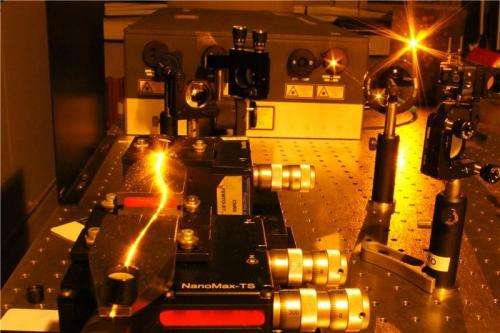Subwavelength optical fibers to diffuse light

Researchers at the Femto-ST Institute, working in collaboration with colleagues from the Charles Fabry Laboratory (CNRS/Institut d'Optique Graduate School), have just discovered a new type of light diffusion in tiny optical fibers 50 times thinner than a strand of hair! This phenomenon, which varies according to the fiber's environment, could be used to develop sensors that are innovative and highly sensitive. The work is published in the journal Nature Communications on October 24, 2014.
Optical microfibres are silica fibres tapered down to a size 50 times smaller than a strand of hair, with an approximate diameter of one micrometer (a thousandth of a millimeter) or even less. To produce these tiny objects, researchers at the Charles Fabry Laboratory heated and stretched optical fibres used in telecommunications, measuring 125 micrometers in diameter. The remainder of the study was carried out at the Femto-ST Institute in Besançon. By injecting a laser beam in these silica microwires, the CNRS researchers observed a new type of Brillouin light scattering for the first time, involving surface acoustic waves. This discovery was subsequently confirmed by a numerical simulation, which helped verify the physical mechanism at play.
Since the diameter of the fibers is smaller than the wavelength of the light used (1.5 micrometers, in the infrared), the light is extremely confined inside. As it travels, it infinitesimally shakes the wire, displacing it by a few nanometers (one millionth of a millimetre). This distortion gives rise to an acoustic wave that travels along the fiber surface at a velocity of 3,400 meters per second, according to the results of the researchers. The wave in turn affects the propagation of the light, as part of the light radiation returns with a different wavelength in the opposite direction.
This phenomenon had never been observed previously, for it only occurs when light is confined in a subwavelength-diameter fiber. In standard optical fibers, light travels essentially in the core of the fiber (with a 10-micrometrer diameter), and consequently does not generate surface waves.
Since the waves generated by the confinement of the light travel along the surface of the microfibers, they are sensitive to environmental factors such as temperature, pressure and ambient gas. This makes it possible to design highly sensitive and compact optical sensors for industry. These results also help improve our knowledge of the fundamental interaction between light and sound on an infinitesimally small scale.
More information: J.C. Beugnot, S. Lebrun, G. Pauliat, H. Maillotte, V. Laude and T. Sylvestre. "Brillouin light scattering from surface acoustic waves in a subwavelength-diameter optical fibre." Nature Communications, October 24, 2014 DOI: 10.1038/ncomm6242
Journal information: Nature Communications
Provided by CNRS





















